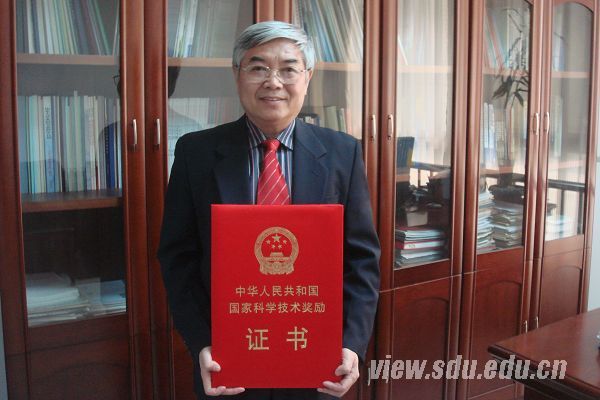The annual National Science-Technology Award Ceremony was held in the Great Hall of the People in Beijing on February 14. Chinese President Hu Jintao, Premier Wen Jiabao, Standing Committee of the Political Bureau of the CPC Central Committee Member Li Changchun, and Vice Premier Li Keqiang attended the ceremony. Shandong University won 5 National Science and Technology Awards.
“Technology and Application of Cellulosic Ethanol Produced from Corncob Residues” accomplished by Prof. Qu Yinbo and his research group, won the second-place of State Technological Invention Award (STIA), and “Key quantitative identification, advanced prediction and disaster prevention technology of unfavorable geological bodies, especially for water-bearing structures” accomplished by Prof. Li Shucai and his research team at the Geotechnical and Structural Engineering Research Center, won the second-place of State Scientific and Technological Progress Award (SSTPA).
Shandong University also received one second-place of State Technological Invention Award and two second-place of State Scientific and Technological Progress Award as the cooperation unit.
|
Dr. Qu Yinbo, Professor of microbiology, director of State Key Laboratory of Microbial Technology, dean of Life Science School, Shandong University. He is also vice president of Chinese Society for Microbiology, Advisory Board Member of Asia Federation of Biotechnology, deputy editor of Acta Microbiologica Sinica, Editorial Advisory Panel Member of Biofuels. |
Prof. Qu Yinbo and his research group cooperated with Shandong Longlive Biotechnology Company introduce the new concept on biorefinery of corncob lignocellulosics. By developing this new technology, they successfully overcame several main bottlenecks in cellulosic ethanol technology: the raw material and pretreatment costs were transferred to high-value products; the cheaper cellulase was produced onsite from cheaper medium; ethanol was produced by simultaneous saccharification and fermentation, and saved from the troubles caused by pentose fermentation. By combining the technology with extracting lignin as new bio-materials, a comprehensive innovative biorefinery system has being established to produce liquid fuel and high-value chemicals from lignocellulosic biomass, and to be mass produced later. After the new technology becomes more widespread, agricultural residue biomass will be utilized efficiently, and will gradually form a new biorefinery industry, partly replacing the petrochemical industry to form a base for sustainable development of human society.
|
Professor Li Shucai, the dean of Civil Engineering School and the director of Geotechnical & Structural Engineering Research Center, Shandong University. He was elected as the president of Underground Engineering Association (UEA) affiliated to Chinese Rock Mechanics and Engineering Society (CRMES). He has been a professor of Institute of Rock and Soil Mechanics (IRSM), Chinese Academy of Sciences (CAS). |
Due to prevention and management problems of serious disasters in tunnel construction, especially for that of water inrush, theories and technologies of quantitative identification and advanced prediction for unfavorable geological bodies have been proposed by the team led by Prof. Li Shucai. Advanced geological prediction technology and equipment, such as compound induced polarization, have been developed. A comprehensive advanced prediction system for unfavorable geology was established as a four-stage integrated process. New grouting materials were invented, and corresponding grouting techniques were carried out to effectively and dynamically control water. All of these theories and technologies are successfully applied in dozens of national key projects. Water inrush disasters are avoided and casualties are reduced, which result in outstanding economic and social benefits.
According to the Regulations on National Science and Technology Awards, reviewed by the vetting committee of the National Science and Technology Awards, approved by the committee of the National Science and Technology Awards, verified by the Ministry of Science and Technology, ratified by the State Council ,and signed by Chinese president Hu Jintao, two Chinese scientists, physicist Xie Jialin and architect Wu Liangyong, won the State Supreme Science and Technology Award at a high-profile annual ceremony held to honor excellent scientists and research achievements. 36 projects received the second-place prizes of State Natural Sciences Award. 2 research achievements earned the first-place in the State Technology Invention Award. 53 research achievements earned second-place of State Technology Invention Award. The project “Theoretical Innovation and Significant Breakthrough in Mineral Resources Prospecting” received the special award of State Science and Technology Progress Award. 20 research achievements earned first-place prizes of State Science and Technology Progress Award. 262 projects received second-place prizes of State Science and Technology Progress Award. 8 foreign experts won the International Cooperation Award in Science and Technology, including three scientists from Japan and five from Germany, France, Britain, the United States and Australia respectively.
Written by: Jing Zizhao, Xu Zhenhao
Photo by: Liu Yinghong
Edited by: Ben Hammer, Jing Zizhao
Source:www.en.sdu.edu.cn, School of Life Science, School of Civil Engineering,www.view.sdu.edu.cn

